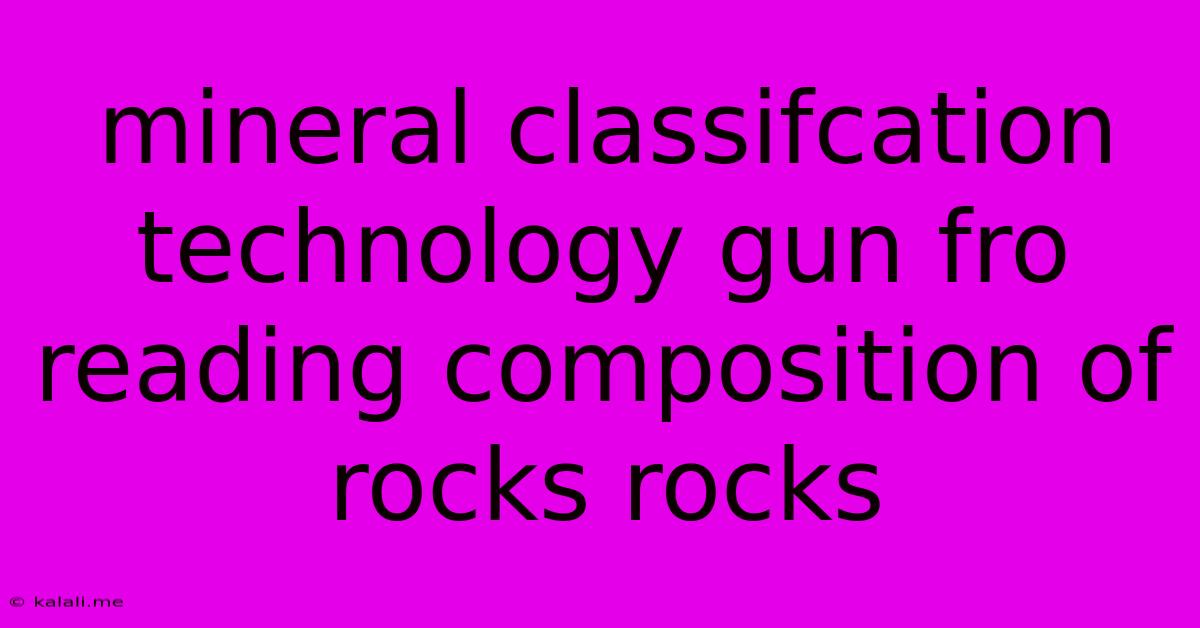Mineral Classifcation Technology Gun Fro Reading Composition Of Rocks Rocks
Kalali
May 30, 2025 · 3 min read

Table of Contents
Revolutionizing Rock Analysis: Mineral Classification Technology for Geologists
Meta Description: Discover how advanced mineral classification technologies, like X-ray diffraction and spectroscopy, are revolutionizing the way geologists determine the composition of rocks, leading to breakthroughs in geological understanding and resource exploration.
Geologists have long relied on traditional methods for rock analysis, often involving laborious and time-consuming processes. However, the advent of sophisticated mineral classification technologies has transformed the field, providing faster, more accurate, and comprehensive data about rock composition. This article explores these groundbreaking technologies and their impact on geological research and resource exploration.
Understanding the Importance of Rock Composition Analysis
Understanding the precise mineral composition of rocks is crucial for a multitude of applications. From geological mapping and understanding plate tectonics to exploring for valuable mineral deposits and assessing environmental impact, accurate compositional data is paramount. This information allows geologists to:
- Identify rock types: Different rock types possess unique mineral assemblages, directly influencing their physical properties and geological context.
- Reconstruct geological history: The mineral composition of a rock can reveal information about its formation environment, age, and the geological processes it has undergone.
- Explore for mineral resources: Knowing the mineral content of rocks is essential for identifying potential ore deposits, guiding exploration efforts, and optimizing mining operations.
- Assess environmental risks: Understanding rock composition is crucial for assessing potential environmental hazards, such as landslides, erosion, and contamination.
Advanced Mineral Classification Technologies
Several advanced technologies are now routinely employed for precise and efficient mineral classification. These include:
1. X-Ray Diffraction (XRD)
XRD is a powerful non-destructive technique that identifies minerals based on their unique crystal structures. X-rays are diffracted by the atomic planes within the mineral crystals, producing a characteristic diffraction pattern. This pattern acts like a fingerprint, allowing geologists to identify the minerals present in a rock sample with high accuracy. XRD is particularly useful for identifying clay minerals and other fine-grained materials.
2. X-Ray Fluorescence (XRF)
XRF is another non-destructive technique that determines the elemental composition of rocks and minerals. It involves bombarding the sample with X-rays, causing it to emit characteristic X-rays unique to the elements present. The intensity of these emitted X-rays is proportional to the concentration of each element, allowing for quantitative analysis. XRF is widely used for rapid geochemical analysis of rocks and minerals.
3. Spectroscopy (Raman and Infrared)
Spectroscopy techniques, such as Raman and infrared spectroscopy, analyze the vibrational modes of molecules within minerals. Each mineral possesses a unique vibrational spectrum, providing another powerful way to identify and quantify mineral phases. These methods are particularly useful for identifying polymorphs (minerals with the same chemical composition but different crystal structures).
4. Electron Probe Microanalysis (EPMA)
EPMA is a highly sophisticated technique that allows for the analysis of individual mineral grains at a microscopic level. A focused electron beam is used to excite atoms within the sample, generating characteristic X-rays that reveal the elemental composition of the targeted area. EPMA provides detailed information about the chemical heterogeneity within mineral grains, offering valuable insights into mineral formation and alteration processes.
The Future of Mineral Classification Technology
The field of mineral classification is constantly evolving, with ongoing developments in instrumentation and data analysis techniques. Improvements in sensitivity, speed, and automation are leading to more efficient and precise rock analysis. The integration of these technologies with advanced data processing and machine learning techniques promises further breakthroughs in geological research and resource exploration. This will allow geologists to gain even deeper insights into the Earth's composition and processes, leading to advancements in many related fields. Further research into portable and field-deployable instruments will also broaden accessibility and allow for real-time analysis in remote locations.
Latest Posts
Latest Posts
-
Wiring Diagram For A Ceiling Fan
May 31, 2025
-
Proportyionasl Editing On But Wont Wortk
May 31, 2025
-
How To Meet The Brotherhood Of Steel New Vegas
May 31, 2025
-
Liftmaster Garage Door Remote Stopped Working
May 31, 2025
-
How To Wire 4 Lights To One Switch Diagram
May 31, 2025
Related Post
Thank you for visiting our website which covers about Mineral Classifcation Technology Gun Fro Reading Composition Of Rocks Rocks . We hope the information provided has been useful to you. Feel free to contact us if you have any questions or need further assistance. See you next time and don't miss to bookmark.